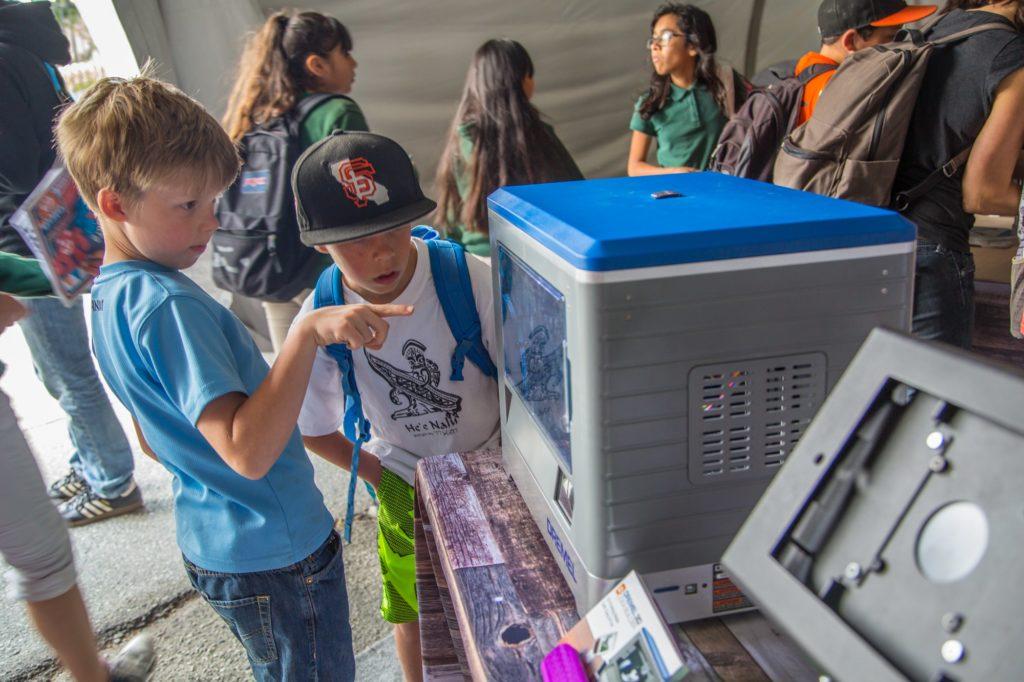
Better yet, attend a Maker Faire, take the whole family, and see exactly what we mean on a larger—and much more exciting—scale. As the 3D printing industry has hit the mainstream like a ton of fabricated bricks, more and more manufacturers have been gearing products and programs toward students, not only recognizing with good common sense where the future of innovation lies, but also working in tandem with the current worldwide push for a science, technology, engineering, mathematics (STEM) agenda. This of course means that at events, much is being geared toward drawing in the younger set, as well as welcoming them en masse; in fact, you’ll probably be one of over a hundred thousand people in attendance.
“I’ve long been following the Maker Movement as a part of my overall interest in STEM (science, technology, engineering and math) education,” says Bajarin. “These shows have become increasingly important as a means to introduce kids to these fields.”
“At Maker Faires, children get hands-on experience with electronic gadgets, from programming to soldering. Kids can play with robotic kits, try building a drone and generally tinker with all sorts of gizmos.”
As Bajarin enjoyed walking around the show he was able to catch speakers from around the world detailing their activities in 3D printing and relating it to the 3D printing community, as well as visiting booths from sponsors like tech titans Google, Microsoft, and the like.
And of course, also in attendance? Lots of very enthusiastic kids. A new exhibitor, the Department of Energy, was hard at work garnering their attention as well. At their booth, kids were actually able to talk with scientists about the future of energy.
“Kids are untapped resources that will help deal with climate change, energy issues and the environment,” said Jetta Wong, director of the DoE’s Office of Technology Transition.
The whole point is thinking about the future and having the patience to invest in humans who won’t really pay off as working professionals for many years. As Bajarin so astutely points out though, if we don’t get them interested—and really interested now—where will the engineers and scientists come from decades from now? This does indeed require seemingly ‘tireless effort,’ but one plus is that the natural magnetism between children and technology like 3D printers will take care of a lot of work. The major effort is just putting them together in a room.
Who was absent from the show, in Bajarin’s estimation? Minorities.
“Still, one concern of mine about the Bay Area Maker Faire is that very few minorities attend this show,” states Bajarin. “This is not the fault of the folks who manage the Maker Faire, as they work extremely hard to make this event inclusive. In fact, on Friday, the first day of the show, they and sponsors LinkedIn, RoboTerra and ThinkLogix brought over 4,000 students from underserved communities to the show to see demos and play with the various projects. However, this underscores the fact that the tech community as a whole has to work harder to get kids of all genders, races and ethnicity interested in STEM, as these scientific disciplines will open up new opportunities for them in the future.”
This certainly can’t be emphasized enough, and not only does the STEM agenda need to be extended to children, but parents as well, who are busy with the general business of work and daily tasks and parenting, and may not truly realize how important encouragement toward STEM curriculum is, offering a toolset that is not only considered to be incredibly valuable for today–but even more so for tomorrow. Have you been to a Maker Faire–or taken your kids to any 3D printing events? Discuss further over in the Kids, Maker Faires & 3D Printing forum at 3DPB.com.
[SOURCE: Time]